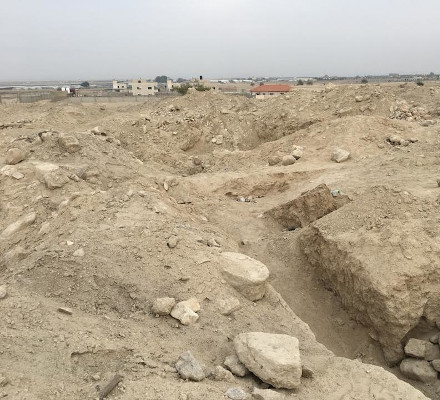ISIS-Style Destruction of Antiquities, Right Here in Israel
A week and a half ago, our staff had a fun day. As archaeologists, we obviously decided to go visit some archaeological sites, but we had no idea what we were about to see.
One of our stops on our trip was at the site of Archelais, which is north of Jericho. It is an ancient site that was built by King Herod’s son Archelaus (who then named the site after himself). Josephus mentions that Archelaus “magnificently rebuilt the royal palace that has been at Jericho, and he diverted half the water with which the village of Neara used to be watered, and drew off that water into the plain, to water those palm trees which he had there planted: he also built a village, and put his own name upon it, and called it Archelais.” (Antiquities 17.340)
In the Roman world, the dates from Archelais and the surrounding region were greatly admired. Pliny the Elder (NH 9.13) describes them as “highly esteemed – the more remarkable quality of these is a rich, unctuous juice; they are of a milky consistency, and have a sort of vinous flavour, with a remarkable sweetness, like that of honey” and they were bequeathed by Salome, King Herod’s sister to Livia, wife of Augustus Caesar (antiquities 18.31). Today, the area still boasts large tracts of date palms. The site of Archelais proper is identified with the ancient ruin of Khirbet el-Beiyudat.
That is until recently.
Archelais was excavated from 1986 to 1999 by Hananya Hizmi who is now the Head Staff Officer of Archaeology for the Israeli Civil Administration in the District of Judea and Samaria. Since that excavation, the site has been left mostly untouched until recent construction by the Palestinian Authority (PA) to turn the surrounding area into a resort.
While this was unfortunate construction encroaching on the archaeological site, the construction stayed to the edges of the site. However, it seems that the men who were brought in to bulldoze the area for the construction realized that the land they were digging was rich with archaeological artifacts. It seems as though they decided to come back and see what they could find and in a short period of time, perhaps days, the almost the entire site was marred by bulldozers, and mass looting for the illicit antiquities market.
What we saw, and what you can see in these pictures is not Syria or Iraq. It’s right here in Israel.
This is quite possible the biggest archaeological destruction in Israeli history. While the Temple Mount may be a more important site rich in antiquities from all different time periods, in size, the whole-sale destruction, covering about 100 dunams (about 25 acres of land) in Archelais is much larger than that of the south-eastern corner of the Temple Mount. We were shocked. We never saw such massive destruction, and we’ve been working with the Temple Mount material for 13 years. There were hundreds of pits, many trenches, and the entire site was turned over by bulldozers looking for archaeological “hot spots.” We could see many archaeological artifacts strewn across the site, including ashlar stones, pieces of architecture, column drums, and farming tools.
So, let’s do a brief history. According to the Oslo Accords, Judea and Samaria is now separated into three areas: Areas A, B, and C. Area C is under the jurisdiction of Israel with full administrative and security control. Area A is under the jurisdiction of the Palestinian Authority with full administrative and security control. Area B is jointly administered with the Palestinian Authority in charge of administration and Israel in charge of security. The Oslo Accords also call to protect and safeguard archaeological sites, prevent damage, respect academic freedom, and grant excavation licenses to archaeologists on a non-discriminatory basis.
It seems that the main problem is that the Archaeology Department of the Civil Administration has little manpower and it seems, little interest in this area of Israel. They have only one person in charge of antiquities robbery, construction supervision, and excavations for this district that encompasses over 3000 sites. This district covers the entire Jordan Valley and southern Samaria. In the Israel Antiquities Authority, on the other side on the “Green Line” there would be 60-70 people in charge of a district of comparable size.
It is a huge problem that Israel is not investing its resources to preserve archaeological sites in Judea and Samaria in areas C or B. The Palestinian Authority also has few staff and lacks resources in their archaeology department.
This type of destruction cannot be allowed to continue or to happen again elsewhere. We brought this destruction to the attention of Channel 2 News in Israel. They interviewed our staff members and an expose was aired last Friday night. The report also had a brief update about the Temple Mount Sifting Project.
We can do better in protecting our archaeological heritage in Israel. We need people who care to speak up and force the government to allocate the necessary funding and resources to the preservation and conservation of archaeological sites throughout Israel.
May 2018 bring us the protection we need for our archaeological sites and our heritage at risk in Israel.















I agree with you! These sites and artifacts must be preserved. I can’t imagine the treasures yet to be discovered. I participated in sifting in 2008 with my family and homeschooling team that toured the Land. Unbelievable. It was an honor to help in a small, small way. I bless the work of your hands and pray for miraculous help and supernatural preservation and intervention!